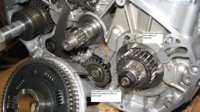I bought a 650 about 9 years ago. It was in rough shape. I rebuilt the engine, cleaned the carbs, and all was good for a 4 years. One day the bike died, the pickup coil had melted. This prompted me to buy a boyer ignition system. While I was mucking with the bike, I decided to finally take care of two problems that the bike had since I bought it; an extremely worn main crank bearing (causing a wiked rattling noise) and a slightly warped lower case (caused a slow and oil leak from the side engine cover). I picked up a used engine, tore it apart, and found that all the bearings in the lower end looked to be in good shape. I used the lower end from the used engine with the good top end from my original engine and put the bike all back together.
I tried to start the bike but was not able to get it to start. The engine seemed to bind up. I tried both the electric starter and the kick starter. Both have the same result. If I step on the kick starter, it goes about a 1/4 of the way down then stops traveling. At that point, I can put all my weight on it and it wont go any further.
I took the spark plugs out, tried starting it, and the problem persists so I don't think its a valve or compression issue. At this point, I am not even far enough along to worry about the ignition or fuel.
I can however turn the engine over slowly by hand. By this I mean I put a wrench on the bolt a the end of the alternator and I am able to turn it by hand, albeit slowly, all the way around without feeling any resistance that is greater than normal. Maybe the issue is related to the starter, or maybe its related to trying to turn the engine over quickly, since it turns over ok at a turtle's pace.
I tore the engine apart again and separated the lower engine case, optimistically hoping to find a broken gear or something obvious. The upper end looked great, no scoring on the cylinders and the valves look good. I cant find anything wrong with the lower end. The crank seems to turn freely and the transmission spins without binding up at all. That was all 4 years ago. I have another bike and plenty of other projects. I just now finally got back around to trying to troubleshoot this engine issue.
I am out of my league with troubleshooting this problem. I have everything apart and I have an entire spare parts engine. Is there anything that I should focus my attention on? Anything that might cause this kind of issue?
Thanks.
Edit: I realized I forgot to mention, its a 1981 xs 650 special.
I tried to start the bike but was not able to get it to start. The engine seemed to bind up. I tried both the electric starter and the kick starter. Both have the same result. If I step on the kick starter, it goes about a 1/4 of the way down then stops traveling. At that point, I can put all my weight on it and it wont go any further.
I took the spark plugs out, tried starting it, and the problem persists so I don't think its a valve or compression issue. At this point, I am not even far enough along to worry about the ignition or fuel.
I can however turn the engine over slowly by hand. By this I mean I put a wrench on the bolt a the end of the alternator and I am able to turn it by hand, albeit slowly, all the way around without feeling any resistance that is greater than normal. Maybe the issue is related to the starter, or maybe its related to trying to turn the engine over quickly, since it turns over ok at a turtle's pace.
I tore the engine apart again and separated the lower engine case, optimistically hoping to find a broken gear or something obvious. The upper end looked great, no scoring on the cylinders and the valves look good. I cant find anything wrong with the lower end. The crank seems to turn freely and the transmission spins without binding up at all. That was all 4 years ago. I have another bike and plenty of other projects. I just now finally got back around to trying to troubleshoot this engine issue.
I am out of my league with troubleshooting this problem. I have everything apart and I have an entire spare parts engine. Is there anything that I should focus my attention on? Anything that might cause this kind of issue?
Thanks.
Edit: I realized I forgot to mention, its a 1981 xs 650 special.







